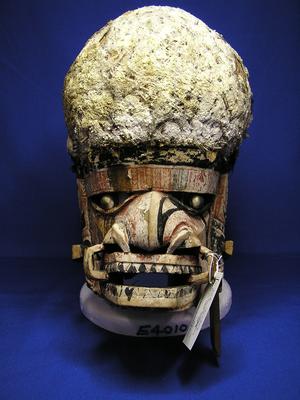Mask - Malagan
Production date
Unknown
Country
Papua New Guinea
State/Province
New Ire
See full details
Object detail
Description
Vanis type Malagan - Tatanua. Stylised interpretation of a male face, with wide gaping mouth.
Opercula set into the eye portion of mask, represent eyes.
Rattan framework is implemented for extended part of mask, excluding face.
Mask (with exception of face) is encased entirely in lime and embedded with small sticks which have been broken off. Underneath lime, can be viewed bark cloth.
Opercula set into the eye portion of mask, represent eyes.
Rattan framework is implemented for extended part of mask, excluding face.
Mask (with exception of face) is encased entirely in lime and embedded with small sticks which have been broken off. Underneath lime, can be viewed bark cloth.
Maker
Production date
Unknown
Production place
Measurements
H299mm x W208mm x L299mm
Media/Materials description
Alstonia villosa lime wood, lime, small sticks (broken off), bark cloth
History and use
The Vanis type Malagan,Tatanua is produced in the northern part of New Ireland and Tabar Island.
Early ethnographic accounts suggested that the word 'Tatanua' incorporated the local names or variants for the spirit 'tanua'; or the soul of the deceased individual.
The Tatanua mask does not represent an individual or his spirit, but the representation of a true man. Not simply in physical characteristics, but within a broader sense of culturally defined male capabilities.
An exclusively male ritual, the Tatanua's dance preparations take place within a sacred men's enclosure, away from the presence of women.
The mask is meant to contain much spiritual power, harnessed by its wearer during the length of the traditional 'Tatanua' dance, which is carried out towards the end of the Malagan ceremony.
The colours incorporated into the design represent certain actions. Red, made from crushed ochre - recalls the spirits of those who have died from violence. Black, from a pigment made from the crushed, heated insides of a nut - is associated with warfare. White, produced from heated, pulverised coral or limestone - an adjunct of numerous magical spells.
Malagan ceremonies are large, intricate traditional cultural events that take place in parts of New Ireland province in Papua New Guinea. The word malagan also refers to wooden carvings which are prepared for the ceremonies, and to an entire system of traditional culture.
Early ethnographic accounts suggested that the word 'Tatanua' incorporated the local names or variants for the spirit 'tanua'; or the soul of the deceased individual.
The Tatanua mask does not represent an individual or his spirit, but the representation of a true man. Not simply in physical characteristics, but within a broader sense of culturally defined male capabilities.
An exclusively male ritual, the Tatanua's dance preparations take place within a sacred men's enclosure, away from the presence of women.
The mask is meant to contain much spiritual power, harnessed by its wearer during the length of the traditional 'Tatanua' dance, which is carried out towards the end of the Malagan ceremony.
The colours incorporated into the design represent certain actions. Red, made from crushed ochre - recalls the spirits of those who have died from violence. Black, from a pigment made from the crushed, heated insides of a nut - is associated with warfare. White, produced from heated, pulverised coral or limestone - an adjunct of numerous magical spells.
Malagan ceremonies are large, intricate traditional cultural events that take place in parts of New Ireland province in Papua New Guinea. The word malagan also refers to wooden carvings which are prepared for the ceremonies, and to an entire system of traditional culture.
Registration number
E4010



